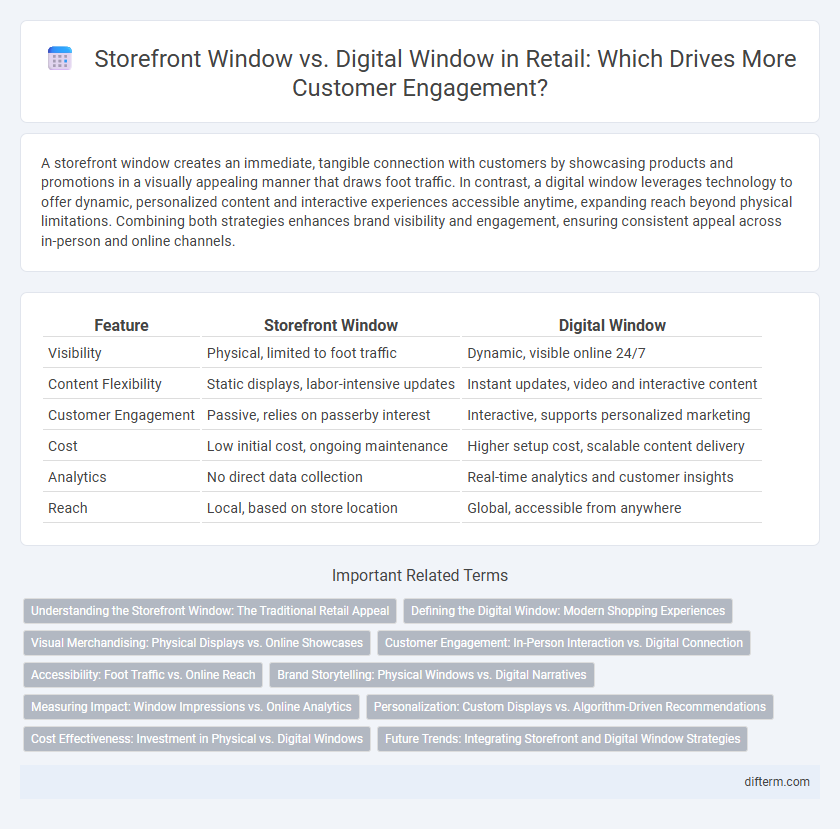A storefront window creates an immediate, tangible connection with customers by showcasing products and promotions in a visually appealing manner that draws foot traffic. In contrast, a digital window leverages technology to offer dynamic, personalized content and interactive experiences accessible anytime, expanding reach beyond physical limitations. Combining both strategies enhances brand visibility and engagement, ensuring consistent appeal across in-person and online channels.
Table of Comparison
| Feature | Storefront Window | Digital Window |
|---|---|---|
| Visibility | Physical, limited to foot traffic | Dynamic, visible online 24/7 |
| Content Flexibility | Static displays, labor-intensive updates | Instant updates, video and interactive content |
| Customer Engagement | Passive, relies on passerby interest | Interactive, supports personalized marketing |
| Cost | Low initial cost, ongoing maintenance | Higher setup cost, scalable content delivery |
| Analytics | No direct data collection | Real-time analytics and customer insights |
| Reach | Local, based on store location | Global, accessible from anywhere |
Understanding the Storefront Window: The Traditional Retail Appeal
The storefront window serves as a vital visual merchandising tool that attracts pedestrians by showcasing curated product displays and brand storytelling, embodying the traditional retail appeal. Its tactile and sensory elements create an immersive shopping experience that fosters emotional connections and encourages foot traffic into physical stores. Compared to digital windows, the storefront window relies on strategic lighting, seasonal themes, and creative layouts to drive consumer engagement and enhance brand visibility in high-traffic retail locations.
Defining the Digital Window: Modern Shopping Experiences
The digital window transforms traditional storefront displays by integrating interactive screens and augmented reality, enhancing customer engagement and providing real-time product information. In retail environments, this technology offers personalized shopping experiences, seamless access to inventory, and dynamic promotions tailored to individual preferences. By bridging physical and digital realms, digital windows redefine how consumers explore products and make purchasing decisions.
Visual Merchandising: Physical Displays vs. Online Showcases
Storefront windows leverage physical displays to create tactile, immersive experiences that entice customers through vibrant product arrangements and seasonal themes. Digital windows utilize online showcases with dynamic visuals, interactive content, and personalized product recommendations to engage shoppers remotely. Visual merchandising strategies in retail optimize sensory appeal in physical stores while driving conversion through digital storytelling on e-commerce platforms.
Customer Engagement: In-Person Interaction vs. Digital Connection
Storefront windows create tangible, sensory experiences that captivate passersby through visual merchandising and physical displays, fostering immediate emotional connections and driving foot traffic. In contrast, digital windows leverage interactive screens and augmented reality to personalize content, enabling dynamic engagement and data collection without geographic limitations. Both methods enhance customer engagement by blending physical presence with digital innovation, optimizing the retail experience and boosting brand interaction.
Accessibility: Foot Traffic vs. Online Reach
Storefront windows attract foot traffic by capturing the attention of pedestrians with visually appealing displays that encourage immediate visits and impulse purchases. Digital windows extend accessibility beyond physical locations, reaching a broader online audience 24/7 through interactive content and targeted ads. Combining both strategies maximizes exposure by leveraging local presence and global reach, enhancing overall sales potential.
Brand Storytelling: Physical Windows vs. Digital Narratives
Storefront windows create immersive brand storytelling through tangible, sensory experiences that engage local audiences and evoke emotional connections with physical displays. Digital windows leverage dynamic visuals and interactive content, offering real-time updates and personalized narratives that captivate online or on-site visitors with versatile brand messaging. Integrating both enhances retail presence by combining immediacy and innovation to strengthen customer engagement and brand recall.
Measuring Impact: Window Impressions vs. Online Analytics
Storefront window impressions provide a tangible gauge of foot traffic and local brand visibility measured through pedestrian counts and in-person engagement metrics. Digital window analytics leverage real-time online data such as click-through rates, user interaction time, and conversion tracking to quantify consumer interest and campaign effectiveness. Comparing physical impression estimates with precise digital analytics enables retailers to optimize marketing strategies by integrating offline presence with measurable online performance.
Personalization: Custom Displays vs. Algorithm-Driven Recommendations
Storefront windows utilize custom displays tailored by visual merchandisers to reflect brand identity and seasonal trends, engaging customers through artful, human-curated aesthetics. Digital windows leverage algorithm-driven recommendations that analyze shopper behavior and preferences in real-time, offering dynamic, personalized content aimed at maximizing conversion rates. Integrating both approaches can enhance customer experience by blending emotional appeal with data-driven customization in retail environments.
Cost Effectiveness: Investment in Physical vs. Digital Windows
Investing in storefront windows involves substantial costs including materials, installation, and regular maintenance, making it a significant physical asset expense. Digital windows require upfront technology investments but offer dynamic content updates and lower long-term operational costs, enhancing cost efficiency. Retailers benefit from digital windows by reducing recurring expenses and increasing marketing flexibility compared to traditional storefront displays.
Future Trends: Integrating Storefront and Digital Window Strategies
Retailers are increasingly merging storefront windows with digital window displays to create immersive, interactive experiences that engage customers both physically and virtually. Advanced technologies like augmented reality (AR) and AI-driven content personalization enhance visual appeal and drive foot traffic by offering dynamic, real-time promotions tailored to passerby demographics. This integration represents the future trend in retail, optimizing brand presence and boosting sales conversions through seamless omnichannel marketing strategies.
Storefront Window vs Digital Window Infographic

 difterm.com
difterm.com